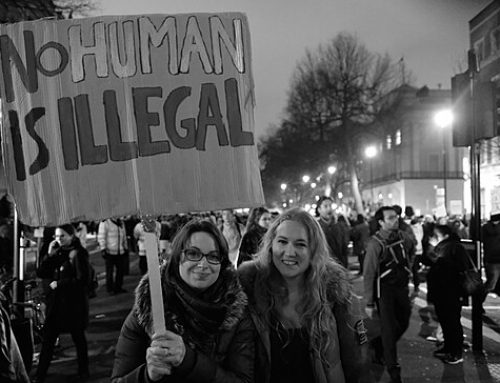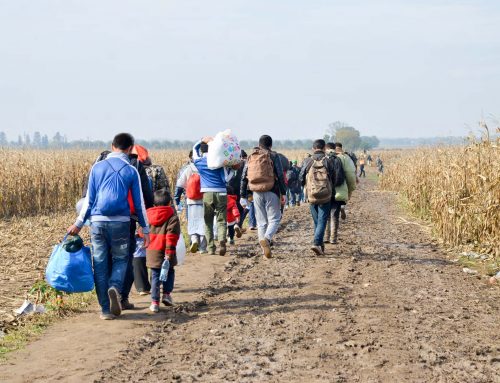This is our first in a series of blogs on the issue of habitual residence written by students from Binghamton University, whom the hub hosted in Summer 2024.
The first is by Amaris Carrillo.
Are recent family reunion refusals on the basis of
Habitual Residence Justified?
Is there a Legal Definition of Habitual Residence?
The concept of habitual residence has evolved over the years. It was first used in an international context in the 1980s and has since gained traction in various legal contexts, including immigration and international law. While there is no definitive definition I will explore the different interpretations used in various legal contexts to gain a better understanding on what they all mean legally. I’ve been interning with the Refugee Rights Hub at Sheffield Hallam University, working to reunite refugees with their families from different places in Africa and the Middle East. Before I dive into the meaning, consider what you know about ‘habitual residence.’ What do you think it refers to, and to whom does it apply? Now that you’ve had time to consider it, it’s important to understand that habitual residence is a complex concept that has been debated over time. This blog will uncover the meaning of habitual residence an explore whether recent refusals are justified or morally correct.
Immigration in the United Kingdom
First, I want to briefly examine the concept of habitual residence concerning immigration rules in the United Kingdom to highlight the differences in definitions. According to the Immigration Appeal Tribunal, “habitual residence” refers to “the country from which the asylum seeker was fleeing persecution in order to seek asylum” in the context of reunification. The House of Lords, based on the relevant tribunal, accepted that “an appreciable period of residence, such as to establish habitual residence, may be as short as a month” (AA, 2004). This definition is important to note as it affects spouse reunification. While being in the United Kingdom under Annex 2: Habitual residence subjects individuals to the habitual residence test, where they must meet certain criteria to be considered habitually resident. This test is used for individuals applying for housing. As mentioned on the United Kingdom government website, this term is not defined in legislation, and there are many external factors to consider when conducting this examination. The main two factors are the individual’s intention for coming to the United Kingdom and whether the individual is a habitual resident of the United Kingdom.
The Hague Convention on the Civil Aspects of international Child Abduction, 1980
As mentioned, there have been developments to this term. It was first used in the Hague Convention on the Civil Aspects of International Child Abduction 1980. Although it is not explicitly defined, it is generally understood as the place where a person, particularly a child, has established a stable and lasting presence, reflecting a degree of integration in a social and family environment. It is determined by evaluating various factors, including the child’s life, family, and social environment. The convention also allowed the courts to have their own interpretations, which have resulted in shaping the understanding of this concept, emphasizing the importance of a fact-specific analysis in each case. The Hague Convention on the Civil Aspects of International Child Abduction 1980 was created to protect children from being abducted by one parent when they leave their habitual residence without the knowledge or consent of the other parent. The goal was to “protect children internationally from the harmful effects of their wrongful removal or retention and establish procedures to ensure their prompt return to the State of their habitual residence, as well as to secure protection for rights of access.”
Cases
In the context of the AA case, habitual residence is defined as “the country from which the asylum seeker was fleeing persecution in order to seek asylum.” This is a crucial concept in both international law and personal status, determining the legal jurisdiction of many issues such as child custody, taxation, and immigration. The concept of habitual residence was used in a broad sense during this case, allowing a refugee to establish a life in a third country before claiming asylum in the intended country.
Bolbol v. Hungary
The Bolbol v. Hungary case played a pivotal role in relation to the Hague Convention on the Civil Aspects of International Child Abduction, 1980. The case involves a stateless person of Palestinian origin who was refused asylum in Hungary (Case Law Database). It showcases the struggle of interpreting ‘habitual residence’ under the Dublin II regulations, which determine which EU member state is responsible for examining an asylum application (Eur-Lex). In this case, it was ruled that determining habitual residence involves examining the totality of the circumstances surrounding the individual’s presence in the member state, such as the duration of the stay, their intentions, and their ties to the member state (familial, social, economic). Under the Dublin II regulations, habitual residence refers to proving a close link to the member state while conveying the intention to stay permanently (Citizens Information). The court refused to recognize Bolbol as a refugee under the 1951 Convention because she did not meet certain criteria, such as fleeing due to fear of persecution on the grounds of religion, race, nationality, membership of a particular social group, or political opinion. Bolbol fled the Gaza Strip and became a resident in Hungary, not having protection or assistance from the UNRWA. She did not renew her visa and claimed asylum instead on the basis of not receiving protection from the UNRWA. From an outside perspective, do you believe that Bolbol should have been refused or granted asylum based on the given definition of habitual residence, and why? It can be challenging to answer such a question considering the ongoing conflict between Palestine and Israel. If she became a resident, what qualifies Bolbol as a refugee within the concept of habitual residence? Understanding that habitual residence holds many definitions can be troublesome since there are many ways to use it legally without having one singular definition.
Conclusion
Based on the various legal interpretations of habitual residence, refusing these applications can be justified due to the ambiguity of the concept, which allows for multiple interpretations. However, it is not morally justified to deny applications solely based on these varying interpretations. In our work at the hub, we’ve encountered two similar cases where one was refused and the other successful, highlighting the fluidity in defining habitual residence. This fluidity underscores the challenges refugees face on their journey to the United Kingdom, where interpretations of habitual residence play a crucial role and can be contested in court.
Are recent family reunion refusals on the basis of Habitual Residence Justified?
Critical Analysis of the Final Act of the UN Conference of Plenipotentiaries on the Status of Refugees & Stateless Persons
Have you heard of the Final Act of the United Nations Conference on Plenipotentiaries on the Status of Refugees and Stateless Persons? If you havent you will learn more about the convention in the blog and the importance of it. I will also explore its relations to the United Nations 1951 Refugee Convention and showcase the strengths and weaknesses and whether these factors morally justify current family reunion applications on the basis of habitual residence in the Final Act.
Background
The Final Act of the United Nations Conference on Plenipotentiaries on the Status of Refugees and Stateless Persons was adopted in 1951 the same year the United Nations 1951 Refugee Convention was. The Final Act established the basis for the 1951 convention which responded to a mass displacement of
individuals following World War 2. The final act convention affirmed the principle that human rights shall enjoy fundamental rights and freedoms without discrimination. Prior to the Final Act the office of the High Commissioner for Refugees provided internationally recognized travel documents to individuals rendered stateless in the midst of the first World War and subsequent conflicts. Meanwhile the 1933 Refugee Convention was the first document in international law to state the critical principle of non-refoulement, which protected refugees from forcible repatriation in cases in which their lives might be in danger. Regardless of their efforts to tackle refugee issues they were constrained in both scope and effectiveness.
So What?
The Final Act of the United Nations Conference on Plenipotentiaries on the Status of Refugees and Stateless Persons provides a clear definition of who qualifies as a refugee, which was crucial in creating a uniform understanding and approach among nations, facilitating international cooperation and ensuring
that those in need of protection could be recognized and assisted. A refugee is someone with a well-founded fear of being persecuted for reasons of race, religion, nationality, membership of a particular social group or political opinion. What about stateless individuals? According to the Final Act of the United Nations Conference on Plenipotentiaries on the Status of Refugees and Stateless Persons “being a person who has no nationality her is, because the circumstance in connection with which he has been recognized as a refugee have ceased to exist, able to return to the country of his former habitual residence”. In this case the Final Act refers to Habitual Residence as the place a person has established a significant degree of continuity and integration in their life. It is used to determine the most appropriate jurisdiction for assessing refugee status and providing protections. While the document allows for a person to receive protection, the concept of habitual residence can present several challenges. Since there is no clear definition provided by the Final Act, it is mainly left to interpretation, and its ambiguity can lead to inconsistent applications across different jurisdictions. The Final Act aims to address stateless persons, but establishing their habitual residence can be complicated as they often lack identity and residency documents. Although the concept of habitual residence is crucial for determining jurisdiction and protecting refugees and stateless persons, it faces several challenges. There are also important aspects that highlight the intent to protect these individuals, such as issuing travel documents to better facilitate the movements of refugees, particularly for their resettlement. The United Nations wanted Contracting States to apply these provisions without discrimination based on race, religion, or country of origin.
Strengths
There are a couple of strengths which are very similar to those of the United Nations Refugee Convention.
- Comprehensive Protection Framework
The Final Act provided a robust legal framework for the protection of refugees. It established clear definitions, principles, and rights, setting a high standard for international refugee law while also recognizing the predicaments of stateless persons. It paved the way for the 1954 Convention relating to the Status of Stateless Persons. - International Cooperation
The Final Act underscored the importance of international cooperation and burden-sharing. It recognized that addressing refugee issues requires a collective effort and the participation of all nations. This is essential as refugee crises often affect multiple countries, and collaborative efforts are necessary to provide adequate protection and support. - Foundation for Future Legislation
The Final Act and the subsequent 1951 Refugee Convention laid the groundwork for later treaties and conventions, such as the 1967 Protocol, which expanded the temporal and geographic scope of the Convention, and the 1954 and 1961 Conventions on Statelessness. It served as a guide for countries in developing their national laws and policies regarding refugees.
Weaknesses
- Geographic and Temporal Limitations
Initially, the 1951 Refugee Convention limited refugee status to individuals displaced by events occurring before January 1, 1951, and primarily within Europe. This limitation was not clearly addressed in the Final Act, which laid the basis for the adoption of the 1967 Protocol years later. While the original framework did not address refugees displaced after 1951, it was designed in the post-World War II context, which may not fully address contemporary causes of displacement. - Lack of Enforcement Mechanisms
The Final Act of the UN Conference of Plenipotentiaries on the Status of Refugees and Stateless Persons relied heavily on the goodwill and cooperation of states, lacking vigorous enforcement mechanisms to ensure compliance. This has led to inconsistent application and protection standards across different countries. - Protection for Stateless persons
While the Final Act aimed to address the status of stateless persons, it was not as developed in international law compared to refugee protection. The aim of this document was to provide provisions for stateless persons, but they often missed out on these benefits due to the lack of identity documents. The separate 1954 and 1961 Conventions on Statelessness were necessary to fill this gap.
Conclusion
The Final Act of the United Nations Conference on Plenipotentiaries on the Status of Refugees and Stateless Persons stands as a pivotal document in international law. It laid the groundwork for contemporary refugee protection and championed principles of human rights, solidarity, and international
cooperation that shape global refugee policies today. However, despite its profound impact, the Final Act initially lacked comprehensive provisions for stateless persons and sturdy enforcement mechanisms, which raises moral concerns regarding refusals for family reunion applications. While the Final Act does not offer a precise definition of habitual residence, it can generally be understood as the place where individuals have established their lives. These interpretations vary across jurisdictions and may exclude stateless individuals or refugees without access to identity documents during their journey to the United Kingdom.








